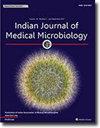Pattern of rapidly growing mycobacteria (RGM) species isolated from clinical samples: A 10-year retrospective study in a tertiary care hospital of Bangladesh
IF 1.4
4区 医学
Q4 IMMUNOLOGY
引用次数: 0
Abstract
Purpose
Infections caused by rapidly growing mycobacteria (RGM) are increasing worldwide. The study was conducted in a microbiological laboratory of Bangladesh to determine the pattern of detection of RGM from clinical samples.
Methods
All laboratory culture records of RGM from 2012 to 2022 were collected retrospectively and analyzed.
Results
A total 62 RGM infected patients with surgical site infection (74.1 %), injection site and skin abscess (9.7 %), septicaemia (4.8 %) and UTI (1.6 %) were identified. The annual isolation frequency of RGM increased 4.8 %–29.1 % in between year 2012 and 2022. RGM infected patients (14.5 %) were mistakenly treated with first line anti tubercular drug before correct microbiological diagnosis (median, IQR; 3, 2–5 months). Out of 23 RGM isolates, 86.9 % were M. abscessus and rest 13.1 % were M. fortuitum. Most of them (≥95 %) were sensitive to amikacin, linezolid, clarithromycin where as 27.1 % to imipenem and ciprofloxacin, 40 % to cefoxitin, 35.3 % and 1.7 % to doxycycline and co-trimoxazole respectively.
Conclusion
Misdiagnosis or delay in diagnosis and erroneous treatment with first line anti tubercular drug may cause prolong morbidity and therapeutic failure to patients with RGM infection. So, early and appropriate diagnosis is crucial for successful outcome.
从临床样本中分离出的快速生长分枝杆菌(RGM)种类的模式:孟加拉国一家三级医院的 10 年回顾性研究。
目的:快速生长分枝杆菌(RGM)引起的感染在全球范围内呈上升趋势。本研究在孟加拉国的一家微生物实验室进行,以确定从临床样本中检测 RGM 的模式:方法:回顾性收集并分析了 2012 年至 2022 年期间所有的 RGM 实验室培养记录:结果:共发现62名RGM感染者,他们分别患有手术部位感染(74.1%)、注射部位和皮肤脓肿(9.7%)、败血症(4.8%)和UTI(1.6%)。从 2012 年到 2022 年,RGM 的年分离频率增加了 4.8%,达到 29.1%。RGM感染者(14.5%)在得到正确的微生物学诊断前(中位数,IQR;3,2-5个月)被误用一线抗结核药物治疗。在 23 例 RGM 分离物中,86.9% 为脓肿霉菌,其余 13.1% 为 fortuitum 霉菌。其中大部分(≥95%)对阿米卡星、利奈唑胺、克拉霉素敏感,27.1%对亚胺培南和环丙沙星敏感,40%对头孢西丁敏感,35.3%和1.7%分别对多西环素和联合曲唑敏感:误诊或延误诊断以及错误地使用一线抗结核药物治疗可能会导致 RGM 感染患者发病时间延长和治疗失败。因此,早期和适当的诊断是成功治疗的关键。
本文章由计算机程序翻译,如有差异,请以英文原文为准。
求助全文
约1分钟内获得全文
求助全文
来源期刊

Indian Journal of Medical Microbiology
IMMUNOLOGY-
CiteScore
2.20
自引率
0.00%
发文量
154
审稿时长
73 days
期刊介绍:
Manuscripts of high standard in the form of original research, multicentric studies, meta analysis, are accepted. Current reports can be submitted as brief communications. Case reports must include review of current literature, clinical details, outcome and follow up. Letters to the editor must be a comment on or pertain to a manuscript already published in the IJMM or in relation to preliminary communication of a larger study.
Review articles, Special Articles or Guest Editorials are accepted on invitation.
 求助内容:
求助内容: 应助结果提醒方式:
应助结果提醒方式:


